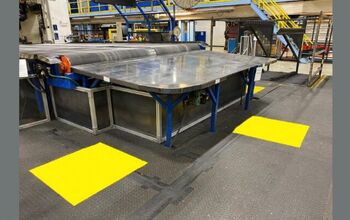Fitch, Moody's, Stand Alone As Subprime ABS Skeptics
Ratings agencies and other players in the finance world are beginning to sound the alarm on auto backed securities. Among the most troubling factors for some investors is the growth of smaller issuers who rely on pools of deep subprime loans. And ratings agencies who are being more conservative with their ratings are missing out on the action.
A report by Reuters highlights a recent ABS offering from Security National Automotive Acceptance Co (SNAAC), a smaller firm that focusing on loans to military personnel. This offering received a solid rating despite seemingly poor fundamentals.
According to the S&P, around 24% have ultra-low FICOs of between 500 and 550. And roughly 24% of the loans have loan-to-value ratios of 115% to 120% – meaning that the borrowers owe more than their vehicles are worth. Even so, S&P rated the deal AA, while rival DBRS gave it a full AAA rating.
Some players in the fixed income industry say that this kind of practice is far from an isolated incident. Ostensibly, a boom in subprime ABS has led to new players who are hungry for loans, regardless of quality
“The gap between the biggest players and the smaller issuers is just massive,” said John Kerschner, the head of securitized-product investing at Janus Capital Group. The smaller second-tier players go to deep, deep subprime – in the range of a 500 FICO score. That may not be the person you want to lend money to.”
Even more troubling is an assertion that ratings agencies Moody’s and Fitch, two well known companies in the bond ratings world have been deemed too cautious by a number of issuers, and thus have not been hired to rate their deals. Needless to say, this effectively stifles any outlooks that are less than rosy. John Bella, a top ABS official at Fitch, told Reuters
“We are generally more reluctant to reach AAA on subprime auto ABS for numerous reasons, among them the sector’s innately more volatile performance history, operational concerns and often heavy reliance on securitization as sole source of funding. Stiffer competition and deteriorating underwriting in recent months are amplifying our concerns.”
While the Reuters piece questions how investors may fare in the event of a burst ABS bubble, TTAC has long maintained that the real risk lies with new cars, the auto makers, and another possible systemic crisis. Auto manufacturers could interpret rising sales in an overly optimistic fashion, and start adding capacity as a result. But if the growth in sales is being driven by subprime lending, then it is inherently vulnerable to a slowing economy or an increase in unemployment. Either of those factors could be the trigger that causes subprime buyers to start defaulting. Used cars are less affected by this problem. They can simply be pumped through the system again and again, and the nature of subprime lending itself means that (if executed correctly) the high interest paid by everyone else can offset the losses brought on be delinquent debtors. If new car sales were to experience a significant contraction due to external forces like these, then auto makers could be left with a 2008-style scenario of idle plants, excess capacity and a glut of inventory, all of which are enormously costly to the OEMs.
More by Derek Kreindler
Latest Car Reviews
Read moreLatest Product Reviews
Read moreRecent Comments
- Mike Bradley Autonomous cars were developed in Silicon Valley. For new products there, the standard business plan is to put a barely-functioning product on the market right away and wait for the early-adopter customers to find the flaws. That's exactly what's happened. Detroit's plan is pretty much the opposite, but Detroit isn't developing this product. That's why dealers, for instance, haven't been trained in the cars.
- Dartman https://apnews.com/article/artificial-intelligence-fighter-jets-air-force-6a1100c96a73ca9b7f41cbd6a2753fdaAutonomous/Ai is here now. The question is implementation and acceptance.
- FreedMike If Dodge were smart - and I don't think they are - they'd spend their money refreshing and reworking the Durango (which I think is entering model year 3,221), versus going down the same "stuff 'em full of motor and give 'em cool new paint options" path. That's the approach they used with the Charger and Challenger, and both those models are dead. The Durango is still a strong product in a strong market; why not keep it fresher?
- Bill Wade I was driving a new Subaru a few weeks ago on I-10 near Tucson and it suddenly decided to slam on the brakes from a tumbleweed blowing across the highway. I just about had a heart attack while it nearly threw my mom through the windshield and dumped our grocery bags all over the place. It seems like a bad idea to me, the tech isn't ready.
- FreedMike I don't get the business case for these plug-in hybrid Jeep off roaders. They're a LOT more expensive (almost fourteen grand for the four-door Wrangler) and still get lousy MPG. They're certainly quick, but the last thing the Wrangler - one of the most obtuse-handling vehicles you can buy - needs is MOOOAAAARRRR POWER. In my neck of the woods, where off-road vehicles are big, the only 4Xe models I see of the wrangler wear fleet (rental) plates. What's the point? Wrangler sales have taken a massive plunge the last few years - why doesn't Jeep focus on affordability and value versus tech that only a very small part of its' buyer base would appreciate?


































Comments
Join the conversation
Going from AAA to AA isn't exactly going to be terrible. But you have to understand something. Auto subprime lending is only going to be dangerous if other parts of the economy falter and people can't pay for their cars. The latest crisis showed how people would let their houses go while making car payments. There was plenty of subprime lending for cars then too. IMHO, the only reason this matters is the economy tanks even further and people aren't able to afford cars. This would be a secondary effect and not a cause.
Sub Prime auto loans are completely different from Sub Prime housing loans. Why? It is a million times easier to repo a car than a house. Housing foreclosures take forever. Automotive recovery is a very quick process. The risk is simply not the same.